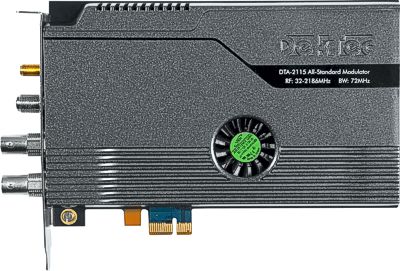
|
ATSC 3.0 Tools - Overview DekTec offers an extensive set of ATSC 3.0 products for developers as well as end users.
|
ATSC 3.0 - Fact Sheet
ATSC 3.0 Products - Quick Links
Hardware products:
| DTA-2115B | All-band modulator for PCIe |
| DTA-2131 | VHF/UHF receiver for PCIe |
| DTA-2139C | 12-channel receiver for PCIe |
| DTU-315 | All-band modulator for USB-3 |
Applications:
| Atsc3Xpress | Signal generator / modulator |
| Atsc3Xpert | ATSC 3.0 receiver / analyzer |
| StreamXpert | Stream analyzer |
ATSC 3.0 for developers:
| DTAPI | SDK with ATSC 3.0 modulation and advanced demodulator API for ATSC 3.0 |
Beyond Physical Transmission
Modulation is only one aspect of the ATSC 3.0 ecosystem. DekTec offers several products for other parts of the protocol stack, e.g.:
| DTA-2174B | 4K UHD input/output for PCIe |
DekTec and ATSC 3.0
DekTec has a long history of developing broadcast modulators and receivers, dating back to the early days of digital television. We have been involved in several major standardization efforts, amongst others in the development of the now ubiquitous DVB-T2.
We are an active member of the ATSC-3 Validation & Verification group, having participated in several "plug fests" to verify interoperability. You can be assured that our products meet the latest ATSC 3.0 standards.
Both our modulator- and receiver technology are highly software-based. We dare to say that our SDR technology is the most advanced in the world. For our customers, this means flexibility (e.g. grow with standard updates) and feature-rich products, e.g. advanced RF measurements and graphs, which are not possible otherwise.
ATSC 3.0 - Convergence of IP and Broadcast
ATSC 3.0 is a suit of standards specifying all layers of a broadcast system including video and audio encoding, transport protocols and physical transmission. Where conventional standards use MPEG-2 Transport Streams, ATSC 3.0 is fully IP based. This enables hybrid broadcast and broadband service delivery e.g. for personalized advertisements.

Hierarchical ATSC-3 constellation
displayed in Atsc3Xpert
The physical layer of ATSC 3.0 supports bitrates from less than 1Mbps in the most robust mode up to more than 57Mbps when using the most efficient mode. One emission can carry multiple modes, allowing delivery of SD, HD and Ultra HD services to fixed as well as mobile receivers.
ATSC 3.0 uses techniques similar to DVB-T2, including OFDM, LDPC error-correction and multi-PLP. It also introduces new elements such as a bootstrap signal, hierachical constellations, new PLP-multiplexing- and time interleaving techniques.
ATSC 3.0 is not compatible with ATSC 1.0 (8VSB). However, DekTec's ATSC 3.0 modulators and receivers also support 8VSB, to ease the transition.
Modulators and Receivers for ATSC 3.0
DekTec offers a number of PC add-on modulator- and receiver products with full support for the latest revision of ATSC 3.0 and legacy support for ATSC 1.0 (8VSB). These units can be used with the ATSC 3.0 applications (next section) for instant generation, reception or analysis of ATSC 3.0, or you can use the SDK to integrate them in your custom ATSC-3 product.
 |
DTA-2115B – All-Standard VHF/UHF/L-Band Modulator for PCIe DekTec's highest-end modulator for satellite, terrestrial and cable standards. The RF output level is programmable from -60 to 0dBm. |
 |
DTU-315 – All-Standard 0-2GHz Modulator for USB-3 Truly portable modulator for satellite, terrestrial and cable standards in a single device. The DTU-315 is bus-powered, so no power supply is required, even when connected to a laptop. |
 |
DTA-2131 – Multi-Standard Cable/Terrestrial Receiver for PCIe
High-quality VHF/UHF receiver and I/Q sampler that comes with a set of software-based demodulators
for an increasing range of QAM- and OFDM-based standards, including ATSC 3.0
and ATSC 1.0 (8VSB). |
 |
DTA-2139C – Twelve-Channel Cable/Terrestrial Receiver for PCIe
Twelve receivers on a single card, each supporting ATSC 3.0, ATSC 1.0 (8VSB)
as well as other standards like DVB-T2, ISDB-T and QAM-A/B/C. |
Applications for Generating and Receiving ATSC 3.0
DekTec offers two general-purpose applications, Atsc3Xpress and Atsc3Xpert, that you can run out of the box to generate, receive and analyze ATSC 3.0 signals. They can be used to create a test transmission with live IP in- and output, power demos, validate your ATSC 3.0 product, etc.
 |
Atsc3Xpress – ATSC-3 Signal Generator Software This application lets you create a broadcast-quality ATSC-3.0 signal from your desk, with full control over all parameters, supporting subframes, multi-PLP, a variety of PLP-multiplexing strategies and more. |
 |
Atsc3Xpert – ATSC-3 Reception and Analysis Software ATSC 3.0 receiver, analyzer and recorder with real-time IP output. The GUI shows advanced RF measurements, signaling info, graphs of #LDPC iterations, transfer function, impulse response and constellation. |
Create Your Own ATSC 3.0 Gear
For product developers, the DekTec SDK (DTAPI) takes away the burden of worrying about the physical-layer aspects of ATSC 3.0 communication. It supports virtually all features of the latest ATSC Physical Layer Protocol specification (A/322), including multi-PLP, multiple subframes, Layered Division Multiplexing (LDM) and Hybrid Time Interleaving (HTI).
To build a transmitter application, you only need to pass modulation parameters and ATSC Link-layer Protocol (ALP) packets. The DekTec SDK takes care of packet scheduling, framing, FEC, interleaving and carrier modulation.
To build an ATSC 3.0 monitoring application, DekTec offers the Advanced Demodulator API, a subsystem of DTAPI for receiving and analyzing RF modulated signals. It provides real-time information about the RF-signal, bootstrap- and layer-1 parameters, constellation diagrams and several graphs. PLPs are decoded simultaneously and passed to the user application as ALP packets.